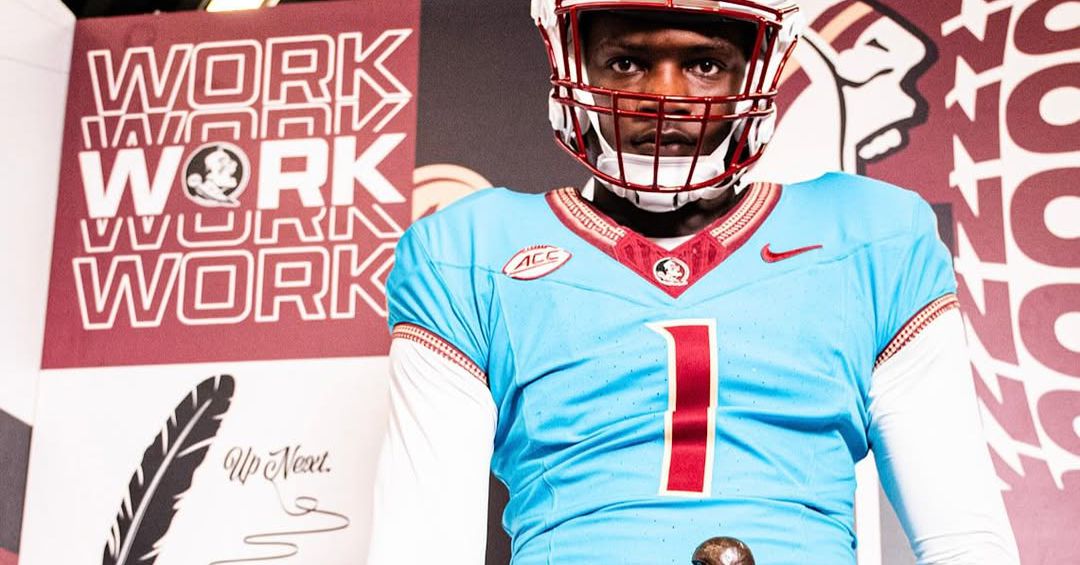In a move that sent shockwaves through the college football recruiting landscape, a top-tier 2026 four-star tight end who was once firmly committed to Texas A&M has now flipped to Florida State, giving the Seminoles a significant momentum boost as they continue building one of the most dynamic recruiting classes in the country. For Florida State, this commitment is more than just a win—it’s a resounding statement that the Seminoles are reasserting themselves as a powerhouse on the national stage.
The tight end, whose athleticism, size, and versatility made him one of the most coveted offensive weapons in the 2026 class, had previously pledged his future to the Aggies. His original commitment to Texas A&M was seen as a cornerstone piece of their offensive future—a player who could stretch the field, block with power, and contribute in multiple phases of the game. But in a stunning turn of events, the standout recruit decommitted, took a closer look at Florida State’s resurgent program, and made the switch.
For Texas A&M, the loss stings. The Aggies had invested significant time and resources into locking down the talented tight end, and his early commitment was a strong signal that Jimbo Fisher and his staff were making major inroads on the recruiting trail. But with the ever-shifting tides of NIL opportunities, coaching changes, and player development trajectories, no commitment is ever truly final until the National Letter of Intent is signed. This flip underscores the volatility of modern recruiting and the growing influence of program momentum and long-term vision.
At Florida State, head coach Mike Norvell and his staff have been on a mission to rebuild the program into a perennial national contender. This latest commitment serves as another step in that climb. The Seminoles’ offense has undergone a significant transformation in recent years, evolving into a high-octane, versatile attack that makes full use of dynamic tight ends. The 2026 recruit clearly saw how he could be a featured part of that system.
What makes this flip even more significant is the broader context of Florida State’s recruiting resurgence. Over the past two cycles, Norvell and his team have prioritized both talent and culture—seeking out athletes who not only have elite measurables but also possess the mindset and leadership qualities to thrive in Tallahassee. This four-star tight end fits that mold perfectly. Standing at 6’5” and weighing over 230 pounds, he combines NFL-ready size with speed, soft hands, and a relentless work ethic that has drawn comparisons to some of the top collegiate tight ends in the country.
The Seminoles’ staff didn’t just secure a commitment—they won a high-profile battle against some of the biggest names in the SEC and ACC. Florida State’s ability to out-recruit a program like Texas A&M, especially for a player who was once solidly in the Aggies’ corner, speaks volumes about the program’s current trajectory and future outlook. It shows that recruits are paying attention to wins, development, and the overall vibe of a program—not just logos and past prestige.
The tight end’s decision didn’t come overnight. According to sources close to his recruitment, he had been quietly watching Florida State’s development over the past season, noting the program’s physical style of play, creative offensive schemes, and strong locker room culture. He reportedly developed a close relationship with the Seminoles’ tight ends coach, who played a pivotal role in helping him visualize how he would be utilized in Norvell’s offense.
Family input was also a factor. The recruit’s parents were impressed with the academic support and player development programs offered in Tallahassee, as well as the program’s commitment to molding players into leaders both on and off the field. The environment at Florida State resonated with the family in a way that ultimately tipped the scales.
From a purely strategic standpoint, the addition of this four-star tight end gives Florida State a versatile offensive weapon who can shift across formations, line up as an in-line blocker, or split out wide to create mismatches against linebackers and safeties. His high football IQ and understanding of route concepts give the Seminoles a true chess piece—someone who can be moved around the field to exploit defenses. His presence will force defensive coordinators to account for him on every snap, which in turn opens up the field for other playmakers.
Florida State’s offensive coordinator is expected to build packages specifically around his skill set. Whether it’s play-action plays that get him behind linebackers or red zone sets where his size becomes a nightmare for defenders, his role will be prominent. And with the Seminoles aiming for a return to College Football Playoff contention, adding elite players at key positions is critical.
In today’s recruiting world, landing a high-level talent isn’t just about the immediate on-field impact. It also creates ripple effects. Top recruits often pay close attention to where other elite players are going. With this commitment, Florida State positions itself as a premier landing spot not only for tight ends but for offensive skill players across the board. The buzz around this flip could help the Seminoles close on other major targets in the 2026 class, especially those who were previously on the fence.
This also signals a broader shift in the national recruiting narrative. For years, Florida State fought to regain its place among the college football elite. After a few down seasons, some wondered whether the program could ever fully bounce back. But between on-field success, top-tier development, and bold recruiting wins like this one, the Seminoles are proving that they’re not just back—they’re here to stay.
Meanwhile, for Texas A&M, the focus will now shift to recovery and reloading. The Aggies still have a strong 2026 recruiting class, and Fisher’s staff will undoubtedly work the phones to reassert their footing in the tight end market. While this loss is a blow, the modern recruiting landscape demands resilience. Expect Texas A&M to remain aggressive in pursuit of another elite tight end to fill the gap.
Still, the sting of losing a player of this caliber—especially one who was already in the fold—cannot be understated. It’s a reminder that in this NIL-driven era of college football, everything is fluid. Relationships, development paths, and fit often outweigh early promises. Programs that can adapt quickly and connect deeply with players and families will win more of these battles than they lose.
In the end, this commitment is about more than a jersey switch—it’s about the belief in a vision. For the 2026 four-star tight end, Florida State isn’t just the next stop on his journey. It’s the place where he sees his future being built. A place where he believes he can thrive, compete, and prepare for the next level. And for Florida State, it’s yet another piece of evidence that the climb back to college football dominance is no longer a theory—it’s happening in real time.



